Seiza is written with two Chinese characters. The character pronounced sei- means "proper, right, true," and by itself can be pronounced tadashii, meaning "just right" or "proper." The character -za means "sitting posture," and is written with an ideograph depicting people sitting on a raised platform under a roof.
Furyu
Saturday, December 23, 2006
Saturday, November 25, 2006
Cultural context
Something to keep in mind when reading Osensei:
"Prior to the late nineteen century and the introduction of Western worldviewes, liturgical and ritual systems centered on shrines and temples were the vehicles through which the Japanese conceptualized their universe, and they provided the only available terminology for questions of physical science or philosophy. For this reason, any effort to completely secularize bugei principles and concepts would do violence to the cultural context in which they originated."
"Prior to the late nineteen century and the introduction of Western worldviewes, liturgical and ritual systems centered on shrines and temples were the vehicles through which the Japanese conceptualized their universe, and they provided the only available terminology for questions of physical science or philosophy. For this reason, any effort to completely secularize bugei principles and concepts would do violence to the cultural context in which they originated."
- Legacies of the Sword, Karl F. Friday
Labels:
cultural
Saturday, November 11, 2006
Bokken porn - Kingfisher
 Appalachian Hickory (grade 6) from Kingfisher.
Appalachian Hickory (grade 6) from Kingfisher.Weight: 580 gr. (light, very light)
Length: 104 cm.
Center of gravity: 48 cm.


Labels:
weapons
Sunday, September 24, 2006
Bokken porn - The old timer
 Japanese white oak, made in Tsukuba, Japan.
Japanese white oak, made in Tsukuba, Japan.Weight: 590 gr.
Length: 104 cm.
Center of gravity: 48 cm.
The inscription is 'AiKi', not sure why the 'Do' was dropped but I have seen this on other Iwama weapons too.


Labels:
weapons
Sunday, July 09, 2006
Tuesday, June 13, 2006
The Myth of Zen in the Art of Archery - Take II
This thread on e-budo is much better then my comments on the subject.
Much, much better.
I suspect that in a way, Kyudo, is even more susceptible to dilution then Aikido. The cultural dynamics are the same though. Kokoro No Yoi was written by Saito Chobo, hitoharikyu menkyo of Ogasawara Ryu school of Kyudo. I especially liked the following:
"Among those who practice kyudo, there are those who say that in yumi it is not necessary to hit the target, or that all that is necessary is that your form is good; there are even those who say that form doesn't matter, that spirit is the most important thing. Of course, those who have a twisted spirit are a pain in the neck no matter what they do; and practicing yumi with bad form is not good. However, to have good form and to not hit the target is against nature. Do not be misled by nonsense. If your shooting form is good, accuracy will surely follow. I want you to not forget that missing the target means that something is wrong.
If you practice yumi diligently, you will gain some kind of spiritual benefit. However, kyujutsu is by its nature a physical activity, so if you want to engage in spiritual training, you will get faster results if you do something like zazen rather than archery."
I suspect that in a way, Kyudo, is even more susceptible to dilution then Aikido. The cultural dynamics are the same though. Kokoro No Yoi was written by Saito Chobo, hitoharikyu menkyo of Ogasawara Ryu school of Kyudo. I especially liked the following:
"Among those who practice kyudo, there are those who say that in yumi it is not necessary to hit the target, or that all that is necessary is that your form is good; there are even those who say that form doesn't matter, that spirit is the most important thing. Of course, those who have a twisted spirit are a pain in the neck no matter what they do; and practicing yumi with bad form is not good. However, to have good form and to not hit the target is against nature. Do not be misled by nonsense. If your shooting form is good, accuracy will surely follow. I want you to not forget that missing the target means that something is wrong.
If you practice yumi diligently, you will gain some kind of spiritual benefit. However, kyujutsu is by its nature a physical activity, so if you want to engage in spiritual training, you will get faster results if you do something like zazen rather than archery."
Labels:
cultural
Monday, April 24, 2006
Zen koan as a sword parry
 As I was reading "The Unfettered Mind" by Takuan Soho, I noticed that the author makes an analogy between a sword parry and a Zen koan. Here are some relevant bits from "The Mysterious Record Of Immovable Wisdom":
As I was reading "The Unfettered Mind" by Takuan Soho, I noticed that the author makes an analogy between a sword parry and a Zen koan. Here are some relevant bits from "The Mysterious Record Of Immovable Wisdom":
if the mind stops with the sword with which a man is going to strike you, there will be an interval, and your own action will be lost. But if in the interval between your opponent's striking sword and your own action you cannot introduce even the breadth of a hair, your opponent's sword should become your own.
and then:
In Zen, if asked, "What is the Buddha?" one should raise a clenched fist. If asked, "What is the ultimate meaning of the Buddhist Law?" before the words have died away, one should respond, "A single branch of the flowering plum" or "The cypress in the garden".
It is not a matter of selecting an answer either good or bad. We respect the mind that does not stop. The non-stopping mind is moved by neither color nor smell.
Sunday, April 02, 2006
"Aikido is generally believed to represent circular movements. Contrary to such belief, however, Aikido, in its true Ki form, is a fierce art piercing straight through the center of opposition.
The nature of the art being such that you are not supposed to adapt to your partner by making a wide oblique turn of your body but are called upon to find your way onward while twisting your hips."
The nature of the art being such that you are not supposed to adapt to your partner by making a wide oblique turn of your body but are called upon to find your way onward while twisting your hips."
- Saito Morihiro , Traditional Aikido, Vol. 5
Sunday, February 26, 2006
Ordering
1. Hands are last.
2. Hips before hands.
3. Feet before hips.
Now, what to do with Kokkyo? Is it is always there?
2. Hips before hands.
3. Feet before hips.
Now, what to do with Kokkyo? Is it is always there?
Friday, February 10, 2006
Which founder?
When one searches Google images for 'osensei'
,the resulting images can be classified as "old sage" and "virile budo master".
The ratio is about 30:1 in favor of the "old sage". I think that this is a cultural choice which also reflects the popular interpretation of Aikido.
Here is my contribution to the popular vote:
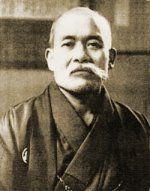 and another one:
and another one:

 and another one:
and another one:

Saturday, January 28, 2006
What did the old man want you to be doing?
An interesting discussion on aikidojournal following a quote from an interview with Shimizu Kenji:
"When I was actively practicing there he often came and went. When he showed up everyone immediately sat down. At first, I thought that people were being courteous toward him. However, it wasn't only that. It was also that the practices we were doing were different from what O-Sensei expected us to do. Once he lost his temper at us. No one realized that he had come and he shouted: "What you people are doing is not aikido."
This was in Hombu dojo in 1963, and I wander if there was dojo of which the Founder would have approved.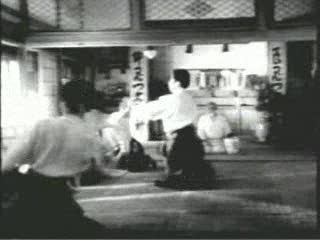
Maybe the one next to his house in Iwama, were he would actually sit, and observe the lessons conducted by Saito Morihiro?
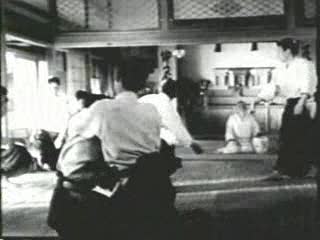
How does it feel to teach Aikido, while being watched by the Founder himself?
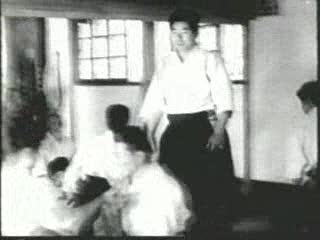
Also, how does it feel to learn Aikido, while being watched by the Founder himself?
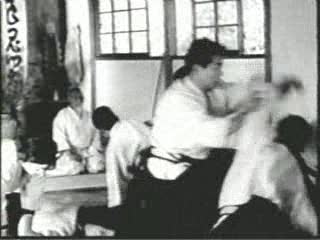
"When I was actively practicing there he often came and went. When he showed up everyone immediately sat down. At first, I thought that people were being courteous toward him. However, it wasn't only that. It was also that the practices we were doing were different from what O-Sensei expected us to do. Once he lost his temper at us. No one realized that he had come and he shouted: "What you people are doing is not aikido."
This was in Hombu dojo in 1963, and I wander if there was dojo of which the Founder would have approved.

Maybe the one next to his house in Iwama, were he would actually sit, and observe the lessons conducted by Saito Morihiro?

How does it feel to teach Aikido, while being watched by the Founder himself?

Also, how does it feel to learn Aikido, while being watched by the Founder himself?

Friday, January 06, 2006
The Myth of Zen in the Art of Archery
 The 'Zen in the Art of Archery' by Eugen Herrigel is fascinating book.
Do not read it though, without reading the 'The Myth of Zen in the Art of Archery'
article by Yamada Shoji (a freely available PDF).
Hers is a direct link,
and this is a google search.
The 'Zen in the Art of Archery' by Eugen Herrigel is fascinating book.
Do not read it though, without reading the 'The Myth of Zen in the Art of Archery'
article by Yamada Shoji (a freely available PDF).
Hers is a direct link,
and this is a google search.
The book describes the spiritual enlightenment of the author as he progresses through kyujutsu studies in 1930s Japan.
The article, on the other hand, describes Herrigen as a person who came to Japan to pursue all things Zen. Not having a solid grasp on the language or the cultural context of his studies, Herrigen sees Zen everywhere. The fact that his teacher "...had no experience in Zen nor did he unconditionally approve of Zen..." has no bearing whatsoever on Herrigen's perception of reality.
These two, are very relevant reading for people who try to make sense of Aikido. They post warning signs all over the place. Just replace kyujutsu with Aikido and Eugen Herrigel with your name, and you are all set.
Labels:
cultural
Subscribe to:
Comments (Atom)




